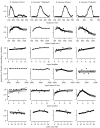Evidence that female preferences have shaped male signal evolution in a clade of specialized plant-feeding insects
- PMID: 17002943
- PMCID: PMC1635466
- DOI: 10.1098/rspb.2006.3635
Evidence that female preferences have shaped male signal evolution in a clade of specialized plant-feeding insects
Abstract
Mate choice is considered an important influence in the evolution of mating signals and other sexual traits, and--since divergence in sexual traits causes reproductive isolation--it can be an agent of population divergence. The importance of mate choice in signal evolution can be evaluated by comparing male signal traits with female preference functions, taking into account the shape and strength of preferences. Specifically, when preferences are closed (favouring intermediate values), there should be a correlation between the preferred values and the trait means, and stronger preferences should be associated with greater preference-signal correspondence and lower signal variability. When preferences are open (favouring extreme values), signal traits are not only expected to be more variable, but should also be shifted towards the preferred values. We tested the role of female preferences in signal evolution in the Enchenopa binotata species complex of treehoppers, a clade of plant-feeding insects hypothesized to have speciated in sympatry. We found the expected relationship between signals and preferences, implicating mate choice as an agent of signal evolution. Because differences in sexual communication systems lead to reproductive isolation, the factors that promote divergence in female preferences--and, consequently, in male signals--may have an important role in the process of speciation.
Figures




References
-
- Alexander R.D, Marshall D.C, Cooley J.R. Evolutionary perspectives on insect mating. In: Choe J.C, Crespi B.J, editors. The evolution of mating systems in insects and arachnids. Cambridge University Press; Cambridge, UK: 1997. pp. 4–31.
-
- Andersson M. Princeton University Press; New Jersey, NJ: 1994. Sexual selection.
-
- Bentsen C.L, Hunt J, Jennions M.D, Brooks R. Complex multivariate sexual selection on male acoustic signaling in a wild population of Teleogryllus commodus. Am. Nat. 2006;167:E102–E116. doi:10.1086/501376 - DOI - PubMed
-
- Blows M.W, Brooks R, Kraft P.G. Exploring complex fitness surfaces: multiple ornamentation and polymorphism in male guppies. Evolution. 2003;57:1622–1630. doi:10.1554/02-507 - DOI - PubMed
-
- Brandt L.S.E, Greenfield M.D. Condition-dependent traits and the capture of genetic variance in male advertisement song. J. Evol. Biol. 2004;17:821–828. doi:10.1111/j.1420-9101.2004.00716.x - DOI - PubMed
Publication types
MeSH terms
LinkOut - more resources
Full Text Sources

